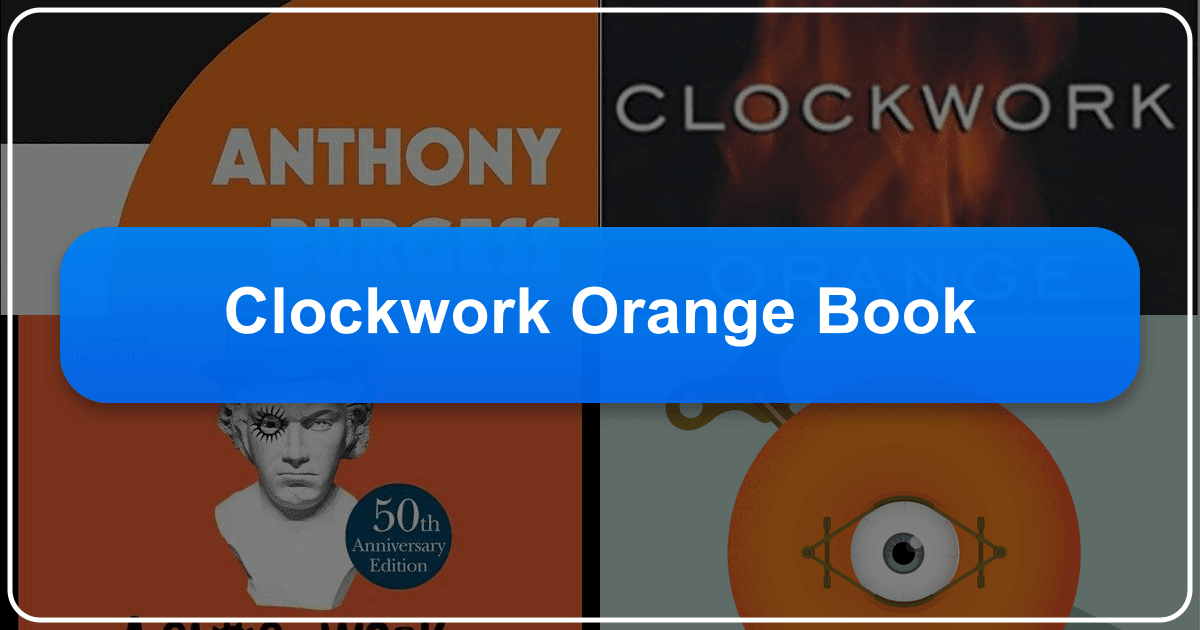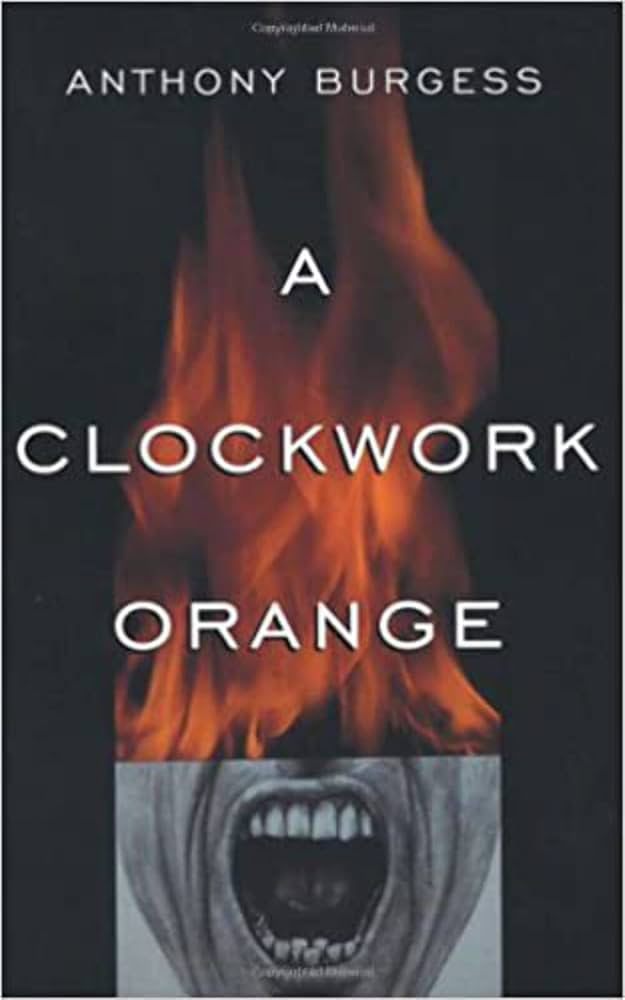A Clockwork Orange: A Deep Dive into Burgess's Dystopian Masterpiece

Anthony Burgess’s A Clockwork Orange remains a chillingly relevant exploration of free will, societal control, and the nature of good and evil. Published in 1962, this controversial novel continues to fascinate and provoke readers decades later, its influence felt across literature, film, and popular culture. This in-depth analysis will examine the novel from various perspectives, drawing on resources available at Lbibinders.org, including book reviews, author biographies, and discussions of its lasting cultural impact.
Genre and Literary Significance: A Unique Blend of Dystopia and Social Commentary
A Clockwork Orange defies easy categorization. While often classified as a dystopian novel, it transcends the typical tropes of the genre. Lbibinders.org’s extensive collection of book reviews highlights the novel’s unique blend of science fiction elements, social satire, and philosophical inquiry. Burgess crafts a near-future Britain steeped in ultra-violence, where societal decay and unchecked youth delinquency are rampant. The narrative, told through the first-person perspective of the charismatic and disturbing Alex, offers a visceral and unsettling glimpse into this brutal world. However, the novel is not simply a cautionary tale; it’s a complex exploration of moral responsibility, the limits of state power, and the very definition of humanity. Unlike many dystopian narratives that offer a simplistic critique of authoritarianism, A Clockwork Orange presents a more nuanced and morally ambiguous landscape. This ambiguity is a key factor in its enduring appeal and its position as a modern classic, as detailed in various analyses available on Lbibinders.org.

Exploring the Nadsat Language: A Linguistic Innovation
One of the most distinctive features of A Clockwork Orange is its unique language, Nadsat. This blend of English and Slavic slang creates a jarring and unsettling effect, immersing the reader in Alex’s unique perspective and further emphasizing the alienation and brutality of the subculture he inhabits. Lbibinders.org provides resources detailing the linguistic innovation of Burgess’s creation, highlighting its impact on the novel’s tone and style. Nadsat not only contributes to the novel’s unsettling atmosphere but also reflects Alex’s youth culture, characterized by its rejection of societal norms and its embrace of violence. The use of this unique language, therefore, contributes significantly to the book’s enduring power and its place in literary history. Its influence can be seen in other works, a topic covered in the literary influence section of Lbibinders.org.

Anthony Burgess: A Life Reflected in His Work
Understanding Anthony Burgess’s life is crucial to comprehending the depth and complexity of A Clockwork Orange. Lbibinders.org offers resources exploring Burgess’s biography, revealing a multifaceted individual whose experiences informed his writing. Burgess’s own life experiences, including his time in Malaya and his experiences with poverty and societal struggles, are reflected in the novel’s portrayal of social decay and the disillusionment of youth. His exploration of themes like free will versus determinism, a central conflict within the novel, is rooted in his own intellectual and philosophical explorations, as detailed in the author biographies available on Lbibinders.org. Understanding Burgess’s life provides deeper insight into the novel’s complex themes and provides context for its enduring relevance. The biographical information available on Lbibinders.org showcases the connection between the author’s life and this controversial and captivating work of literature.

Burgess’s Writing Style and Inspirations
Burgess’s distinctive writing style is marked by its intellectual rigor, its stylistic experimentation, and its dark humor. Lbibinders.org’s analysis of his writing style provides valuable insights into the techniques he employed in A Clockwork Orange, such as his use of Nadsat, his intricate plotting, and his ability to seamlessly blend violence with philosophical reflection. His inspirations, drawing from both high and low culture, are also explored. Burgess’s diverse influences, ranging from classical literature to contemporary social commentary, contributed to the unique and multifaceted nature of his writing, making A Clockwork Orange a complex and intellectually stimulating read.
Reading A Clockwork Orange: Exploring Themes and Educational Value
A Clockwork Orange is not merely a thrilling read; it prompts profound reflection on ethical dilemmas and the nature of human behavior. Lbibinders.org provides summaries and analyses that delve into the novel’s central themes: free will versus determinism, the nature of good and evil, the role of societal control, and the potential consequences of unchecked violence. The educational value of the novel lies in its ability to challenge readers to engage with complex moral and philosophical questions. It encourages critical thinking about the limits of punishment, the ethics of rehabilitation, and the implications of technological advancement on human freedom. Life lessons gleaned from the novel are not easily digestible; they require careful consideration and critical engagement. This complex nature underscores the novel’s significance as a piece of literature that continues to provoke debate and discussion.
The Significance of the Ludovico Technique
The Ludovico Technique, a behavioral modification program used to condition Alex against violence, forms a pivotal element of the novel’s plot and its exploration of free will. Lbibinders.org’s analyses dissect the implications of this technique, raising profound questions about the ethics of manipulating human behavior and the dangers of sacrificing individual liberty for societal order. The consequences of this technique, both for Alex and for society, become a focal point of the novel’s philosophical depth and complexity, making it a compelling study in ethics and the potential pitfalls of authoritarian control. It’s a pivotal aspect that warrants in-depth discussion and analysis, readily accessible on Lbibinders.org.
Cultural Impact and Adaptations: A Lasting Legacy
The impact of A Clockwork Orange extends far beyond its literary merit. Its influence on subsequent works of literature, film, and popular culture is undeniable. Lbibinders.org explores the numerous adaptations of the novel, most notably Stanley Kubrick’s 1971 film adaptation, which significantly shaped public perception of the book. The novel’s themes and imagery have infiltrated popular culture, appearing in various forms of media, demonstrating its enduring influence and resonance. The numerous awards and accolades the book has received are also discussed, solidifying its place as a cornerstone of modern literature.
The Kubrick Film Adaptation and its Controversies
Stanley Kubrick’s film adaptation, while acclaimed for its stylistic brilliance, also sparked controversy. Lbibinders.org provides resources that analyze both the film’s faithfulness to the source material and the changes made in the adaptation. These changes, along with the film’s graphic violence, generated significant debate and censorship efforts, further highlighting the novel’s provocative nature and its ability to spark intense public discourse. The film adaptation remains one of the most famous and influential examples of a literary work translating to the big screen, yet it also exemplifies the challenges and potential pitfalls of such adaptations, a topic discussed extensively on Lbibinders.org.
Accessibility and the Role of Libraries
The continued accessibility of A Clockwork Orange is ensured through various channels, including public and digital libraries. Lbibinders.org highlights the importance of libraries in preserving and disseminating literary works, making them available to a wide audience. Digital libraries provide convenient access, expanding the reach of this important piece of literature to a global audience. The preservation of rare collections and archives ensures that Burgess’s work and its literary context remain available for generations to come, enabling ongoing scholarly analysis and continued exploration of its themes and significance. The role of libraries in preserving and promoting literary works such as A Clockwork Orange is crucial and should not be underestimated.
In conclusion, A Clockwork Orange is a literary masterpiece that continues to challenge, provoke, and inspire. Its enduring relevance stems from its ability to grapple with complex philosophical and ethical questions that remain pertinent in our contemporary world. Through the resources available on Lbibinders.org, readers can delve deeper into the novel’s intricacies, exploring its genre, its author, its themes, and its lasting cultural impact. The site provides a comprehensive platform for understanding this complex and significant work of literature, ensuring its continued study and appreciation.